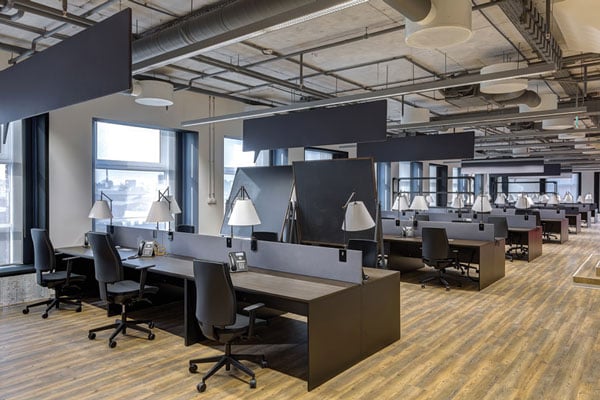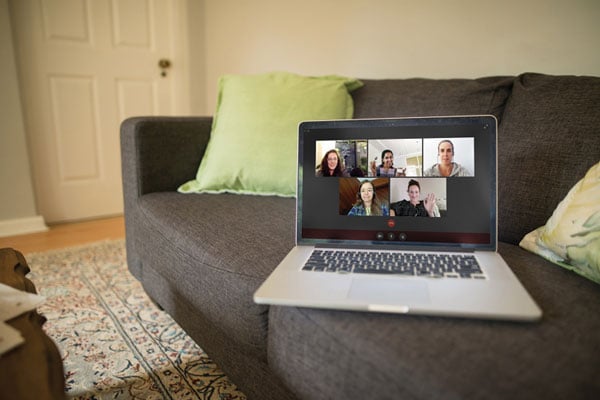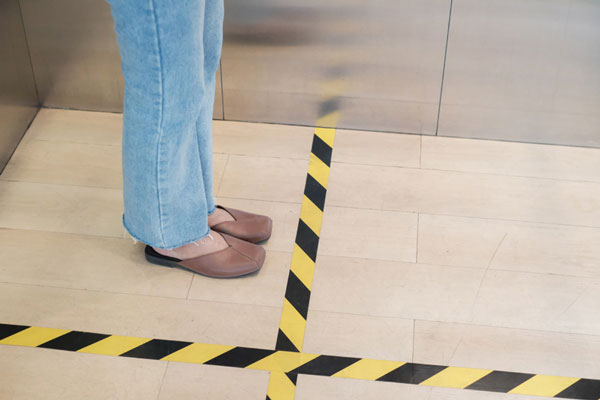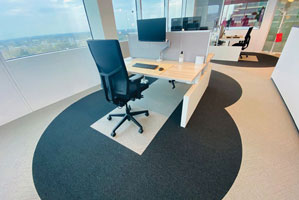Will Teleworking Change the Future of the Office?

The COVID-19 pandemic might not have a massive economic effect on the office sector, but it could spark big new ideas on the use of space.
The office sector appears to be less vulnerable to disruptions associated with the coronavirus pandemic than retail or hospitality, but it’s not entirely immune to an economic downturn — or the acceleration of changes in the ways people have been working during the crisis.

The open-office concept, which is used in about 70% of U.S. offices, could decline in the aftermath of the coronavirus pandemic. Getty Images
Mandatory closures and other social distancing measures have taken a toll on firms that are closely tied to the consumer economy, such as the British airline Flybe, which went bankrupt in March after travel bookings plummeted in the wake of the coronavirus pandemic. Businesses that cannot conduct most of their business remotely are also in peril. On the other hand, many companies have learned that they can run their operations without anyone physically in the office, a trend that has the potential to depress demand for traditional office leases.
“High-priced office space, and new construction in particular, is going to see a hit,” said Anirban Basu, CEO of Baltimore-based economic consulting firm the Sage Policy Group, during a recent webinar with NAIOP D.C.-Maryland. “People are going to be thinking about what kinds of commitments they’re going to make, and cash is king right now. If you’re trying to preserve cash, that doesn’t take you into A-plus office space necessarily. And if you do use A-plus office space, you’ll probably try to rent less of it. You’ll have more people telework if possible.”
A Turn to Teleworking?
Remote work got a prominent plug in April when Morgan Stanley CEO James Gorman told Bloomberg Television that he believed the $60 billion investment bank could operate with “much less real estate” in the aftermath of the coronavirus pandemic.
“We’ve proven we can operate with effectively no footprint,” he said of the firm, which has more than 500 locations around the world. “Can I see a future where part of every week, certainly part of every month, a lot of our employees will be at home? Absolutely.”
CNBC reports that Nationwide is permanently transitioning to a hybrid work model following its positive experience with remote work arrangements. Food and beverage company Mondelez is also exploring transitioning more employees to alternative work arrangements as a way to reduce costs in a recession. And Jes Staley, CEO of Barclays, believes companies may permanently move away from centralizing large numbers of staff in a single building: “The notion of putting 7,000 people in a building may be a thing of the past.”

The pandemic has led to a huge rise in teleworking, which could reduce demand for office space. Getty Images
Many office workers and managers would welcome these changes. A March 30 poll by Gartner of 317 finance leaders and CFOs indicated that 74% of them plan to permanently shift some of their workforce to teleworking. Additionally, a recent poll by career planning site Zippia.com shows that 51% of workers would prefer a full-time work-from-home arrangement.
However, the same Zippia.com survey found that nearly 60% of those workers didn’t think teleworking would become permanent. Many commercial real estate professionals tend to agree.
“I think the office is here to stay,” said Gregory May, executive vice president and West Region market leader for Newmark Knight Frank, during a recent NAIOP webinar. “But I also think there’s definitely going to be a percentage of people who will work remotely permanently.”
Prior to the pandemic, about 4% of U.S. workers were able to work from home at least half the time, according to a Global Workplace Analytics analysis of 2018 American Community Survey data from the U.S. Census Bureau. A national survey by MIT during the first week of April showed that 34% of former commuters were working from home.
Al Pontius, national director of office and industrial for Marcus & Millichap, believes there is a real appeal to telework, but he doesn’t see demand for offfice space falling off a cliff in the near future.

In China, many office elevators now have tape on the floor to ensure that passengers follow social-distancing guidelines. Getty Images
“I see a counterpoint that’s equally strong,” he said during a recent NAIOP webinar. “While we might want the flexibility of telecommuting, we’re all learning that we miss our communities of colleagues. There is a very strong counterweight to the idea that we’re all going to work from home. Certainly the flexibility to do so is increasing, but it’s a little early to say.”
Spencer Levy, chairman of Americas research and senior economic advisor for CBRE, also doesn’t see a secular shift after the pandemic is over in which most workers abandon their offices.
“Even though we believe that more people now see that working from home is doable, every survey we had done prior to the coronavirus crisis showed that working in the officee is much more productive,” he said during a recent webinar for NAIOP Maryland. “We think that’s not going to change.”
New Designs for Offices?
May says that when people do return to the office, the spaces might look a little different for reasons related to health and safety.
“There might be some density issues where they want to be separated a little more,” he said. “That could change the layout of offices.”
Levy also sees office densification changing in the wake of social distancing.
“The average square footage for an average person in an office, which had gone so dense, we believe that pendulum will swing back to adding more square footage,” he said. “That comes directly out of my conversations with some of the largest occupiers in the world.”
According to Robin, a Boston-based office technology company, North American offices average about 150-175 square feet per person. Open office spaces, which have grown in popularity in recent years, average roughly 125-175 square feet per worker. (Christian Beaudoin of JLL told the New York Times in February that 70% of U.S. offices have some form of open plan.)
While popular, open office designs can allow viruses to spread more easily than traditional office layouts. Without walls or a cubicle divider, droplets from a sneeze or cough can spread farther. Offices that use unassigned desks — a common practice in coworking — can also make it easier for a virus to spread as new desk occupants come into contact with infected surfaces. In the face of the coronavirus outbreak, these design features are now a concern, as was demonstrated by an outbreak in March at a crowded open-floorplan call center in South Korea. According to a study published by the U.S. Centers for Disease Control and Prevention, 94 of 216 workers came down with the coronavirus. Almost all of them sat in close proximity to each other.
Offices in China, where COVID-19 first struck, are coming back online, but many of the social distancing and hygiene measures that began at the height of the pandemic are still in place. Masks, hand sanitizer stands and spot temperature checks with handheld digital thermometers are ubiquitous. Some commercial facilities use infrared cameras to scan people for fevers before entering. Eunice Yoon, CNBC’s Beijing bureau chief, reported in March that elevators in China’s capital use tape to mark where passengers should stand for proper spacing.
However, limiting the number of passengers on elevators in high-rise offices with thousands of workers could create long waits in lobbies. For example, global marketing company Interpublic Group told the Wall Street Journal in May that if only two or three of its staff at one of its locations could ride an elevator at one time, it would take two or three hours for them all to reach their offices.
“How many people can work in the building if you limit the number of people in an elevator to two at a time?” Staley asked in a recent interview with the Financial Times.
What’s Ahead?
As restrictions lift across the country, look for a gradual phase-in of workers, possibly with staggered schedules or shifts.
“There could be A teams and B teams working different days,” Scott Rechler, the chief executive and chairman of RXR Realty, told the New York Times in April.
Concerns about clean surfaces could lead to the deployment of new technologies. For example, the South China Morning Post reported in March about Easpeed, a company in China that has developed “no-touch” hologram buttons for elevators. Existing “no-touch” technologies could be put into greater use in common areas. These include voice- or motion-activated doors and dispensers in bathrooms, kitchens and common areas.
Another change could involve antimicrobial materials in interior design elements, such as door hardware. These coatings are made of materials such as silver, copper or chitosan, which is derived from shellfish. Many are already in use in health care settings.
Longer term, Dror Poleg, a former real estate and technology executive, thinks office space will evolve to serve dual purposes.
“Companies will need offices to build culture or to train people or to allow them to interact for specifc tasks,” he said during a recent online discussion between real estate professionals in the U.S., the U.K. and France. “At the same time, employees don’t have to be in the office all day long. That means companies will need to attract people to come to the office and offer them something they don’t have at home.”
To draw workers to a building, it will be critical to make the offce experience richer and more convenient, said Ronen Journo, senior vice president-enterprise at WeWork.
“I think we’re going to see people question the purpose of the office,” he said during Poleg’s panel discussion. “Not just workers but employers as well. Placemaking developed in the last decade. I think it’s going to continue, and I think it’s going to bring the relationship between occupiers, landlords and operators a lot closer. People are going to question why they commute when they can do what they need to do at home. We will see companies begin to offload space, and we will see people working from multiple places — not just from home.”
Shawn Moura, Ph.D., is research director at NAIOP. Trey Barrineau is managing editor, publications, for NAIOP.
The Six-Feet OfficeIn response to the coronavirus pandemic, Cushman & Wakefield recently unveiled a new office setup called the Six-Feet Office. It’s based on the social-distancing rule to keep six feet of space between yourself and other people to prevent the spread of the coronavirus. 
Cushman & Wakefield’s Six-Feet Office features concentric circles on the carpeting around desks, a visual reminder to stay six feet away from other workers. Cushman & Wakefield In a Six-Feet Office, “transparent shields divide desks, markers direct foot traffic and disposable desk pads catch germs and can be discarded when a worker leaves for the day,” according to an April article in the Wall Street Journal. Here are the elements of the Six-Feet Office, according to a post on 6 Feet Quick Scan: “A concise but thorough analysis of the current working environment in the field of virus safety and any other opportunities for improvement.” 6 Feet Rules: “A set of simple and clear workable agreements and rules of conduct that put the safety of everyone first.” 6 Feet Routing: “A visually displayed and unique routing for each office, making traffic flows completely safe.” 6 Feet Workstation: “An adapted and fully equipped workplace at which the user can work safely.” 6 Feet Facility: “A trained employee who advises on and operationally ensures an optimally functioning and safe facility environment.” 6 Feet Certificate: “A certificate stating that measures have been taken to implement a virus-safe working environment.” |
Coworking and Coronavirus: A Canary in the Coalmine?By Shawn Moura, Ph.D. Prior to the coronavirus pandemic, the future of coworking and flex space looked strong. For example, a 2019 JLL study predicted that 30% of the office market will be flex space by 2030. The coworking industry grew substantially along with the protracted bull market, and it’s well documented that coworking was a primary driver of new office absorption across most major markets, especially during the past three to five years, said Michael Kloppenburg of Avison Young’s flexible office solutions during a recent NAIOP webinar. Coworking grew on average 26% per year from 2010-2018, and growth in 2019 was estimated to be 35% year over year before WeWork’s failed IPO. Prior to WeWork’s troubles, much of the criticism of coworking and the flexible office business model focused on the challenges that coworking operators would likely face in a recession, when clients could easily end short-term memberships to conserve cash. “Due to the structure of most coworking deals with landlords, primarily long-term leases, and the short-term nature of their client agreements, there is significant cash-flow exposure,” Kloppenburg said. However, he said that he’s seen renegotiations happening during the coronavirus pandemic as operators attempt to leverage this crisis to secure more favorable terms, or convert leases to management agreements on a case-by-case basis. “I have seen amazing support from many of these operators, providing resources to small businesses. So far, in talking with my colleagues, retention has been better than expected,” Kloppenburg said. “I am bullish on the underlying demand for flexible office space, regardless of the current crisis.” Vulnerable by DesignWeWork and other coworking firms were often on the cutting edge of open-office design and were emulated by tenants in traditional leases. Because of that, their dense office layouts could be seen more as an asset than a liability. Many coworking companies have opted for office layouts that encourage close contact between occupants to facilitate interaction. For example, WeWork intentionally narrowed office corridors so workers would be more likely to interact with each other. In the face of the coronavirus outbreak, these design features are now a cause for concern. In response to the pandemic, WeWork rolled out new guidelines for its offices in April. These include reductions on meeting room capacity, “buffer seating” in public areas to keep six feet of separation between workers, one-way foot traffic paths, and more signage about hand-washing and social distancing. Threatened by SubleasesIn addition to member concerns about infection risks at coworking facilities, these spaces may also be vulnerable to growing competition from more traditional subleases. Jason Hughes and David Marino of tenant representation firm Hughes Marino expect that traditional office leases will struggle to compete with subleases offered at belowmarket rates by tenants with older multiyear leases, especially since many of these spaces are already furnished and technologically equipped. That makes them more attractive for companies interested in minimizing capital investment. Commercial real estate professionals have long speculated that an increase in subleases during a recession could pose a threat to the viability of coworking firms. Subleased space competes directly with coworking and flexible office spaces, as both options appeal to firms interested in short-term commitments for furnished space. But coworking operators generally charge their members more on a per-square-foot basis than they would pay for a traditional lease, let alone a below-market sublease. As Serendipity Labs CEO John Arenas noted in June 2019, flexible office operators who rent entire offices or floors to enterprise clients are particularly at risk of competition from subleases, as these clients are well-positioned to take advantage of large sublease opportunities that become available. Adapting to ChangeCoworking and flexible office operators took a variety of steps to respond to the coronavirus outbreak. Washingtonian magazine reports that coworking operators in the Washington, D.C., area provided members with hand sanitizer and disinfectant, increased cleaning, replaced bulk food with individually wrapped snacks, allowed employees to work remotely and asked sick members to remain home. Other coworking companies took steps such as restricting nonessential business travel, limiting member guests, terminating sick members who failed to selfquarantine, and offering a range of web-based services such as virtual offices and digital happy hours. Both Common Desk and Work Suites also allow members to use private offices that have not been rented out. Common Desk has removed chairs from its common spaces to allow members to distance themselves from each other. Jamie Russo, executive director of the Global Workspace Association, said during a recent episode of the Everything Coworking podcast that in addition to having plans in place to improve hygiene and cleanliness, coworking operators need effective communication policies and should develop contingency plans in case they need to close. She observes that operators are taking steps such as putting together procedures to disinfect an entire location when an infection is detected and closing spaces to new member tours. She also notes that to mitigate impacts to short-term cash flow, some operators are asking those who want to cancel their memberships if they will instead accept a voucher or credit for later use. Long-Term ImplicationsThe coronavirus has severely impaired coworking firms’ business operations and revenues. Larger firms such as WeWork, Knotel, Convene and Industrious have announced furloughs and layoffs since the outbreak began, and several operators have temporarily closed some or all of their locations. However, it remains to be seen how people’s experience with the virus will affect long-term demand for coworking after the outbreak ends. Some in the industry, such as JeanYves Huwart, are optimistic that coworking can thrive after the virus passes. In an article for Work Design Magazine, Huwart speculated that if companies become accustomed to staff working from home, they may see less value in returning to traditional centralized work arrangements and may be more open to distributed work models that include coworking. Timothy H. Savage, a clinical assistant professor at New York University’s Schack Institute of Real Estate and co-author of the NAIOP Industrial Space Demand Forecast, thinks that coworking could accelerate after the pandemic passes. “We have to recognize that coworking, in the sense that it provides space for lease on a short term, is similar to instantaneous pricing,” he said during a recent NAIOP webinar. “It’s a little like distinguishing between bonds and equities. There is an option value to short-term leases. It is valuable both to the tenant and the landlord. The question is, does coworking accelerate through this process? Yes, quite possibly, if we recognize essentially that teleworking during the coronavirus pandemic is a form of coworking. The value of that optionality shouldn’t be lost on the industry.” Shawn Moura, Ph.D., is research director at NAIOP. NAIOP Managing Editor Trey Barrineau and Senior Communications Manager Brielle Scott contributed to this report. |




